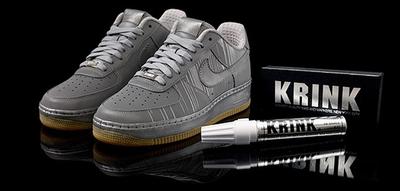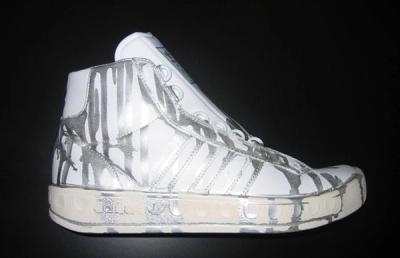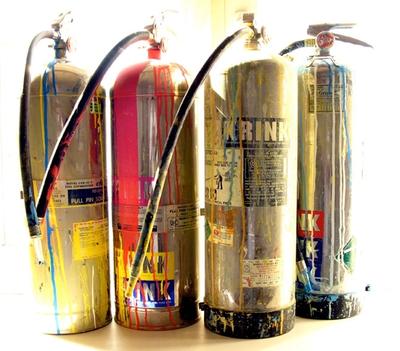Krink Interview
Who knew dripping paint on a wall could get you worldwide fame! Well if you’re the mastermind behind a revolutionary brand such as you may well be on your way. Not content with regular paint and spray, Craig Costello (aka KR) set out to concoct a mixture to blow minds and fill his pockets with loot! An avid artist, KR was always on the look-out for something more - a step away from the filled-in fonts and tags that were becoming the norm in the graffiti scene. With a clever package and a simple solution, KRINK dripped its way around the globe, "allowing KR’s trademark aesthetic to develop in the hands of artist and vandals worldwide." We caught up with the man behind the brand on the eve of his first local tour!
Growing up in New York, how did the street art and graffiti of the time influence you to start doing your own thing?
Graffiti was everywhere and a part of the general landscape. Most of my friends dabbled in it, and graffiti was a style that young kids explored their creativity with. I think at that time the overall attitude was DIY, we were young kids with not a lot of money, we made our own skate ramps, stole spray paint, and painted illegally in the backs of warehouses etc.
How did you discover and master your signature stylings of the 'drip'? What started it all off?
I wanted to stand out and separate myself from other writers. Having my own ink turned out to be a great solution, because I was able to push my aesthetic with my own product. It took a while for people to figure out what I was doing. By then I had established my style, people saw it was successful and started to copy it. Everything was a very natural progression, there was little to no planning. The root of it is wanting to separate myself from the norm and experimenting with materials and style.
Did you always relate your style of art to graffiti?
I started as a totally traditional graffiti bomber. I was all about racking paint and materials, doing tags, throw-ups, and simple styles.
All the other more abstract stuff came much later because I became a bit bored with graffiti in the traditional sense, it began to feel very restrictive and the 'scene' also felt restrictive and full of rules. I wanted to do something different, so I removed my name, KR, from the equation, but the methods and attitude remained very similar. The response I got was really positive, and I saw that a lot of different people were interested in what I was doing, not just graff writers.
Did you truly see yourself as broadening the realms of what street art could be? It seems that your style stood out from other graff artists that were neatly ‘filling in’ lines!
My time as a graffiti writer informs a lot of what I do. I am not just a 'street' artist. I am interested in contemporary art and design. I went to art school and studied conceptual art and photography. 'Street' art to me is cool, but I do not always associate myself with the current explosion. I like to think of myself as a creative person that can apply myself to many fields. I am not solely speaking to graffiti writers or 'street' artists with my work. I want everyone to be interested. Also, I feel that for some people out there graffiti and the 'street' is very free. You create your own rules and impose your vision on the city.
Back then, what paints were you using?
I have always been about economy. When I was younger I racked 100% of my materials. Rustoleum was the number one paint of choice, but beggars can't be choosers, so I would take what I could get. When spray paints became harder to get, I started using bucket paint. Again, it was economy and accessibility, for me this was a very important part of my process. A gallon of paint and a couple of cans of spray and I was all good. Eventually, I went to all bucket paint, as I saw it as a natural progression and at the time the use was very limited by other writers. If anything most writers frowned on bucket paint. I am open to new materials and ideas. A wet sponge on a dusty window is just as cool and effective as a can of paint.
How then did you come to create your own signature mixture that became KRINK?
Experimentation. I knew what I wanted, and how I wanted it to look. I tried a wide variety of things and over time I developed Krink. Krink is all about individual style.
When did you start to see interest in Krink taking off?
When I was living San Francisco it was still pre-internet. News traveled much slower. People would come to SF and see Krink and immediately try to copy it. The Krink style was a must have/use if you spent any time in SF back then. When I moved back to NYC. I met Alife and had also just been featured in 'The Art of Getting Over' by Steve Powers. The book/press helped me to be recognized specifically for Krink on a wider platform. Alife thought Krink was really interesting and helped me package and sell it. I was really surprised at the response. It sold right away and people were always very positive from day one. Also, Irak a crew of young graffiti writers took to Krink right away and started really killing streets in downtown NYC. The street presence was undeniable, and NYC being what it is, a lot of people noticed, and were like, 'What the hell is this?, and where can I get some?' Over time the demand continues to grow globally.
The distinct font and labelling has become one of the strongest selling points of your brand. What were your strategies for packaging the product?
With the packaging, it was very important from the very beginning to have something that was not hip hop or graffiti. I wanted Krink to be multi-dimensional and not specific to one thing. I wanted clean and simple. The packaging does not direct you, it's up to you to use it to create something. We try not to tell people what to do. I didn't want to paint myself into a corner.
You’ve said that artist who used your products in the beginning stages of launching Krink, were the key marketing tools you needed to get the paints onto shelves around the world – how so?
I feel that my greater creative community has been so supportive of Krink and the Krink style. And it is the creative people out there using Krink that spreads the word. Graffiti writers, street artists, young kids. People are genuinely interested, in the products and the story. People saw that Krink had a very specific style that they had not seen before and this was attractive. People are very interested in the things they see happening in NYC.
How then did you start coming to the attention of global corporations such as and ?
I would say it is a mix of the internet and NYC. Many people have their eye on NYC and it's often via the internet. I also feel that a lot of designers are interested in Krink for a number of reasons and those are the people who might pitch a project. The Krink aesthetic continues to grow in popularity.
You ended up working with Nike on the the shoe, created as part of , late last year. Only 18 other artists/musicians had the chance to take part in the campaign….how did you become involved with this and what sort of brief did Nike give you to follow?
They contacted me and asked. It was all pretty simple and straight forward. They gave me a lot of freedom and were really open to my ideas.
As an entrepreneur who started their own brand from scratch, what did you learn from them?
Well, Nike is huge. They have tons of people working for them and big budgets. We are so so small, there is no comparison, except maybe that Nike was started by runners and Krink was started by artists.
You’ve worked with many well-known companies to co-brand the KRINK name, from to and - each brand utilising the KRINK name in a different demographic. What are the key elements you look in making sure KRINK is branded to its full potential?
We have a personal relationship with the brands you mention. In today's world of co-branding we try to be careful of who we work with. We want diversity, but we won't work with just anyone. It's difficult because we want to be open, but it's important to be careful with our brand.
Are you always completely satisfied with the outcome of your work?
I am very controlling. I am not always satisfied, some of my friends say I am too hard on myself and never satisfied. I can't say I am confident in everything. I have to see the finished piece. I am very confident in some areas, but some things can be so new that it takes time to understand the process.
You’ll be hitting up Australia in the next few weeks as part of your exhibition in conjunction with, and – is this your first time to our shores?
Yes, it's my first time! I am very excited at the opportunity. I know graffiti is really big there, but I can't say I'm very familiar with the local scene.
What’s up next for Krink?
We have a number of products and projects coming up, but I don't like to talk about them until they are complete.
Thanks KR!






